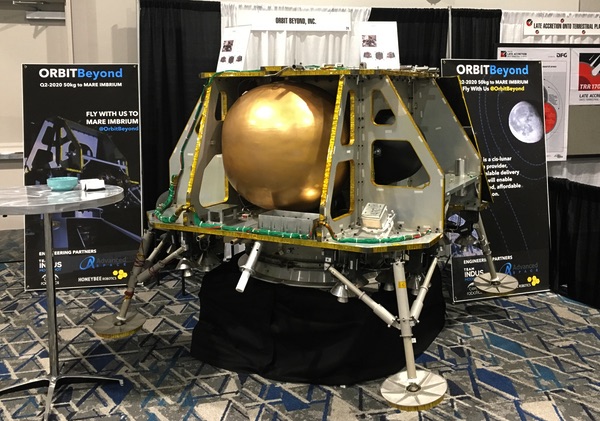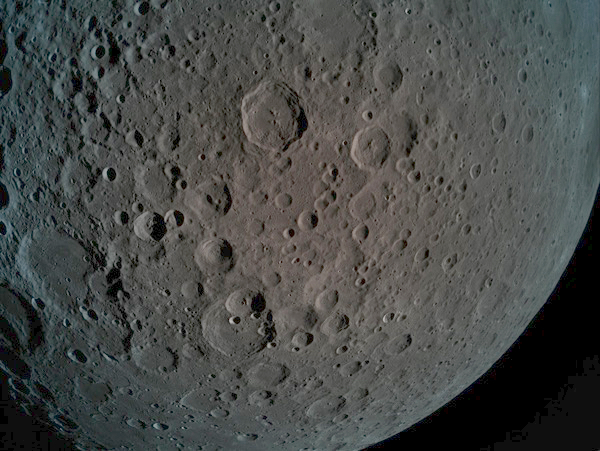Science, commerce, and the Moonby Jeff Foust
|
| “We have to learn something new, expand our intellectual horizons, do some science,” Aharonson said, recalling early talks with the SpaceIL team. “They said, ‘That sounds great, but probably not this time around.’” |
The primary purpose of the mission is simply to demonstrate that it can be done. SpaceIL started as one of many competitors in the Google Lunar X PRIZE, which for a decade offered a $20 million grand prize for the first privately funded organization to land a spacecraft on the Moon, travel at least 500 meters across it surface, and return images and video. The prize expired last March without a winner, but SpaceIL, funded largely through philanthropic contributions and working with Israel Aerospace Industries to build the lander, continued as part of an effort to stimulate interest in science and education among Israeli students.
The mission will also do some science—well, a little. Oded Aharonson, a professor of planetary science at the Weizmann Institute of Science in Israel, recalled meeting with the three founders of SpaceIL to discuss the mission. “I kept asking them, ‘What are you going to do when you get to the Moon?’” he recalled in a talk last month at a lunar exploration workshop outside Houston. They explained they would carry out the tasks required by the X PRIZE Foundation. “‘And then what?’ And then they said, ‘We’re going to Rabin Square and celebrate.’”
To Aharonson, that seemed like a missed opportunity. “We have to learn something new, expand our intellectual horizons, do some science,” he said. “They said, ‘That sounds great, but probably not this time around.’”
Eventually, he was able to get SpaceIL to incorporate some science objectives as well. That includes characterizing the landing site, measuring magnetic anomalies in the lunar crust, and demonstrating precise ranging. That last objective will be achieved with a laser retroreflector five centimeters across provided by NASA as part of a cooperative agreement between it and the Israel Space Agency.
Besides the retroreflector and the lander’s cameras, the main science instrument on Beresheet is a magnetometer. “The main science objective, I would say, of the mission is to measure lunar crustal magnetism,” said Aharonson, who leads an international science team he put together for Beresheet. “We’re trying to understand how and when the lunar crust acquired its magnetization. Both of these questions are intimately related to the ancient history of the Moon.”
The magnetometer, provided by a research group at UCLA, weighs in at less than a kilogram. “It’s a very robust instrument, with no commanding,” he said. “You just turn it on.” Initial tests of the instrument while the spacecraft was still in Earth orbit showed it to be in good condition.
Even if Beresheet lands successfully, it’s likely to operate for only a short time, as it’s not designed to survive the lunar night. While SpaceIL intends this as a one-off mission, IAI has discussed using the lander design. In a later talk at the conference, Meir Nissim Nir, director of advanced space systems at IAI, said future versions of the lander could host 30 to 60 kilograms of scientific payloads. IAI already has an agreement in place with German company OHB to study the use of such landers to carry out missions for the European Space Agency.
Beresheet is also a glimpse at the future of how scientists can work with non-government entities on lunar missions. It’s one that may require both scientists and companies to rethink their assumptions about how such missions should work, based on experience from past government-led missions.
“I don’t know what the next generation of commercial and private spacecraft to the Moon are going to look like,” said Aharonson, “but I can tell you that this marriage between science and commercial interests has been challenging and interesting, and it’s clearly a huge opportunity for all of us.”
| “We’re really on the verge of being able to visit the Moon very, very rapidly,” said Jim Head. “What are the really transformative things we can do with these small missions?” |
The two-day meeting, called Microsymposium 60 and held just before the start of the 50th Lunar and Planetary Science Conference (LPSC) last month, was intended to help improve those marital relations, if you will. During the meeting, scientists discussed investigations they would like to carry out at the Moon using instruments that could fly on commercial landers, while representatives of several companies working on those landers discussed the technical capabilities of those spacecraft and their development status.
There was certainly excitement about the possibilities. “We’re really on the verge of being able to visit the Moon very, very rapidly,” said Jim Head of Brown University, one of the organizers of the meeting. “What are the really transformative things we can do with these small missions?”
That interest has been stimulated by NASA’s Commercial Lunar Payload Services (CLPS) program, which awarded contracts to nine companies last November that are developing lunar landers (see “Three ways to the Moon”, The Space Review, December 3, 2018.) NASA also recently selected a dozen instruments from researchers within the agency that could fly on those landers, and is in the process of reviewing proposals from outside investigators for another set of instruments.
What’s next is to start matching up those payloads with the CLPS landers. At the workshop, and later sessions of the overall LPSC, NASA officials said the agency would soon release the first CLPS “task order,” to which CLPS companies would respond with proposals about how they would carry out the mission. At the time, they expected awarding a contract by the summer.
However, that time frame may have moved up. At the March 26 National Space Council meeting in Huntsville, Alabama, where Vice President Mike Pence announced that NASA was now directed to land people on the Moon by 2024 (see “Lunar whiplash”, The Space Review, April 1, 2019), NASA administrator Jim Bridenstine said the agency was also moving ahead with CLPS.
“We just released the first task order this morning” for CLPS, he said. “There’s some people, maybe, out here in the audience who need to be checking their email right now.”
He said proposals were due in a month, with awards to follow a month later “to commercially land small payloads on the surface of the Moon as soon as possible: maybe 2019. The goal, of course, is 2020.”
| “Sample return may belong still in the Discovery/New Frontiers” classes of planetary science missions led by principal investigators, Hopkins said. |
But a 2019 mission seems unlikely. During a panel session in another LPSC side meeting, representatives of six of the companies with CLPS awards—Astrobotic, Deep Space Systems, Lockheed Martin, Masten Space Systems, Moon Express, and OrbitBeyond—were asked when their landers would be ready. The answers ranged from the middle of 2020 to the end of 2021 (the latter the requirement to win a CLPS award). There’s no evidence that the other three CLPS companies—Draper, Firefly Aerospace, and Intuitive Machines—will be ready any sooner.
One of the companies that expects to be among the first to fly, OrbitBeyond, is basing its lunar lander on designs originally developed by TeamIndus of India for the Google Lunar X PRIZE. (TeamIndus is part of the OrbitBeyond team, but the lander will be built in the United States as required by the CLPS program; the company is planning to establish that assembly facility in Florida.) An engineering qualification model of the company’s lander was on display at LPSC, showing off its ability to carry 40 kilograms of payload on that mid-2020 mission.
 An engineering of OrbitBeyond’s first lunar lander on display at the 50th Lunar and Planetary Science Conference last month outside Houston. (credit: J. Foust) |
The panel session was an opportunity to gather insights from scientists about what payloads they’d like to fly and what technical requirements they had. It became clear, though, that there was a gap between the expectations of many researchers and the current capabilities of the CLPS providers. The session used an online polling system to gather inputs from the audience. Complex missions, like sample return and in situ resource utilization (ISRU), were among the most popular missions desired by those in the room, even though such missions are beyond the initial capabilities of most CLPS landers.
Josh Hopkins of Lockheed Martin said that they've looked at ISRU applications for its McCandless lander, and that drove the “rather large solar array” on it. Sample return, though, might not be as feasible. “Those kinds of missions benefit strongly from having a very integrated science team working with the engineering team on the mission,” he said, a different approach than buying such a mission as a commercial service. “Sample return may belong still in the Discovery/New Frontiers” classes of planetary science missions led by principal investigators, he said.
Others, though, said they were more flexible. “This is a very market-driven approach, and this is part of the culture shift happening now,” said Alain Berinstain of Moon Express. “I drive a bus. My bus will do what you need it to do, if the price is right and there’s a market for it.”
| “We’re taking this one step at a time, and we’re proving out the capability, and it’s really important that we do that very, very well because the whole space community is watching,” Hendrickson said. |
Scientists also sought the ability to have their payloads operate for more than one lunar day, so that they, and the lander they’re on, need to survive the lunar night. Most CLPS providers, though, don’t expect their initial landers to operate more than one lunar day. “For our first mission we’ll only be surviving and operating for eight Earth days,” said Dan Hendrickson of Astrobotic.
That mismatch between scientific expectations and commercial capabilities highlighted a deeper issue. “We’re really building the first railroads to the Moon, in a sense,” Hendrickson said. “So, hopefully, we don’t get ahead of ourselves and expect certain capabilities to be there. They will be there. We’re going to get there.”
“But we’re taking this one step at a time, and we’re proving out the capability, and it’s really important that we do that very, very well because the whole space community is watching,” he continued. “That’s why we’re taking a very conservative approach to try and get this right the first time.”
“Everybody’s just getting started,” said Steve Clarke, deputy associate administrator for exploration in NASA’s Science Mission Directorate, at the end of the two-hour panel discussion. He suggested a series of workshops featuring the scientific community, instrument providers, and lander developers, “so we can work through these types of things.”
On Thursday, the whole space community will be watching to see if Beresheet is able to land successfully. Aharonson mentioned that Beresheet means “in the beginning.” “In a lot of ways, I think it represents how to do these things for the first time.”
Note: we are temporarily moderating all comments subcommitted to deal with a surge in spam.
